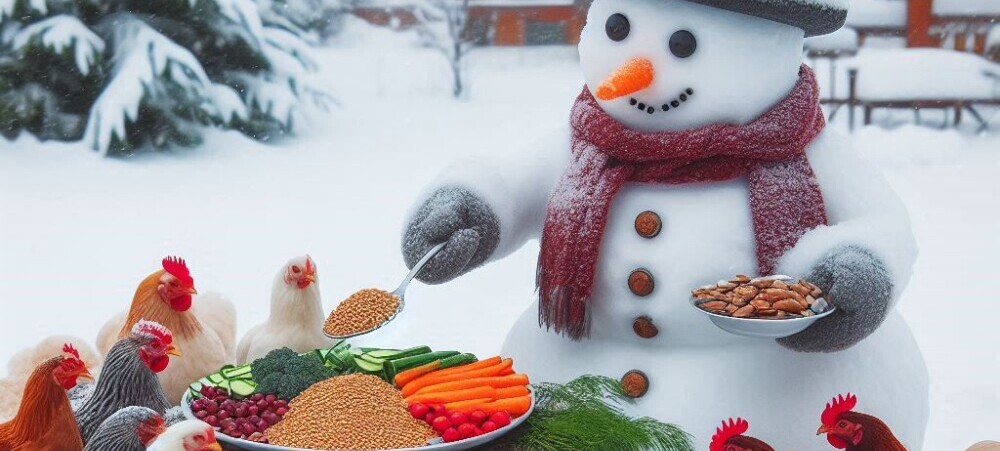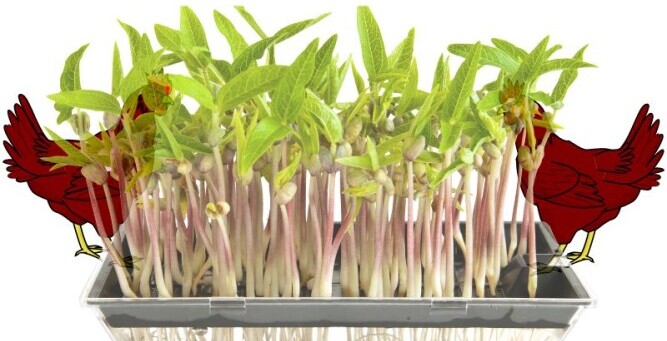
Winter can be challenging for your chickens. As temperatures drop, their nutritional needs change, and finding the right balance is key to keeping them healthy. Trust me, I’ve been through my fair share of frosty mornings, and the old saying holds true: an ounce of prevention is worth a pound of cure.
One major issue in winter is that chickens burn more calories to stay warm. They’re focused on keeping their feathers fluffed up and internal heaters running. Without proper nutrition, they won’t just be cold; they could become sick.
We’ll break down the essentials of a winter diet for free-range chickens, explore the types of greens that can benefit your flock during these chilly months, and look at how to keep feed costs low without compromising on quality. If you’re prepared to make a few adjustments, you can help your chickens not just survive but thrive during winter.
Optimal Winter Diet for Free-Range Chickens
Feeding free-range chickens in winter poses unique challenges. When the ground is frozen or covered in snow, it’s tough for them to forage like they usually do. So, what do free-range chickens eat in the winter? The answer lies in a mix of natural and supplemented foods that cover all their nutritional bases.
First off, grains are your best friend in the cold months. Grains like cracked corn, wheat, and barley are excellent energy sources. They provide the carbohydrates that chickens need to generate body heat. It’s not only effective but also something chickens love pecking at.
Cracked grains are hard, so keep some grit around to help their gizzards withstand the challenge of hard foods.
Don’t forget about protein. Chickens need their protein boost to keep laying eggs and maintain feather quality. You can add mealworms, black soldier fly larvae, soybean meal, or even scrambled eggs to their diet. These protein-rich foods help them stay strong and healthy.
Fresh veggies are another must-have. Even in winter, you can offer them chopped cabbage, carrots, squash, and peas. These veggies provide essential vitamins and minerals. And if you don’t mind a bit of effort, sprouting grains or seeds can be a great source of fresh greens when nothing’s growing outside.
A word of caution: don’t overfeed the soft foods. Crops can become engorged, plugging up the works so the blockage won’t move forward or backward without help. If that happens, watch this video to find out what to do.
Finally, don’t underestimate the value of good quality chicken feed. While free-range chickens usually supplement their diet by foraging, quality feed ensures they get all the nutrients they might miss in winter.
Opt for feeds explicitly formulated for cold weather, with higher fat content to meet their increased energy needs.
Essential Greens for Winter Feeding

Greens aren’t just for summertime. During winter, your chickens still need those vital nutrients from fresh greens to stay healthy and happy.
Kale, spinach, and Swiss chard are excellent options. They are hardy and can withstand colder temperatures. You can easily grow them in a small indoor garden or even in a greenhouse if you have one. Even better, these leafy greens are packed with vitamins A, C, and K, which are great for egg production and overall health.
Brassicas like broccoli and cabbage also come in handy. These veggies not only provide essential nutrients but also help keep chickens engaged. They enjoy pecking at large chunks of cabbage or broccoli heads, and it’s a good way to prevent boredom.
Sprouted grains are another fantastic option. Wheat, barley, or even mung beans can be sprouted indoors. They are easy to grow and offer fresh, nutritious greenery that chickens can’t resist. The process is simple and doesn’t require a lot of space or effort.
If you can’t grow your own greens, local farmers’ markets or grocery stores sometimes have discounted veggies that are still perfectly fine for chicken consumption. Just make sure they’re free from pesticides and chemicals.
Cost-Effective Winter Feeding Solutions
Keeping feed costs low during winter doesn’t mean compromising on quality. There are plenty of ways to feed your chickens without breaking the bank.
Consider kitchen scraps. Your chickens can benefit from leftover fruits, vegetables, and grains that might otherwise go to waste. Just avoid anything salty, sugary, or moldy. Chicken favorites include apple slices, carrot peels, and cooked rice or pasta.
Homegrown options are also a budget-friendly way to keep your flock well-fed. If you have room, growing root vegetables like carrots and beets can be really rewarding. These veggies store well and can provide fresh food throughout the winter.
Another great idea is fermenting chicken feed. Fermented feed is highly digestible and increases nutrient uptake, meaning you get more bang for your buck. It’s as simple as soaking their regular feed in water for a few days until it starts to ferment.
Don’t forget to let your chickens forage even in winter. They might not find as much, but they can still peck at fallen seeds, insects, and any greenery poking out through the snow. It keeps them active and supplements their diet.
You can also create DIY supplements to enhance their nutrition. Crushed eggshells provide calcium, and oyster shell supplements are excellent for strong eggshells. Mixing grit into their feed helps with digestion, especially when they’re eating more grains and seeds.
Get creative with your resources. Collect fallen leaves in the autumn and use them as bedding in the coop. Your chickens will forage through the leaves, finding hidden bugs and seeds. Plus, as the leaves break down, they add nutrients to the soil, making it a win-win for your garden come spring.
Dave

Chickenmethod.com

